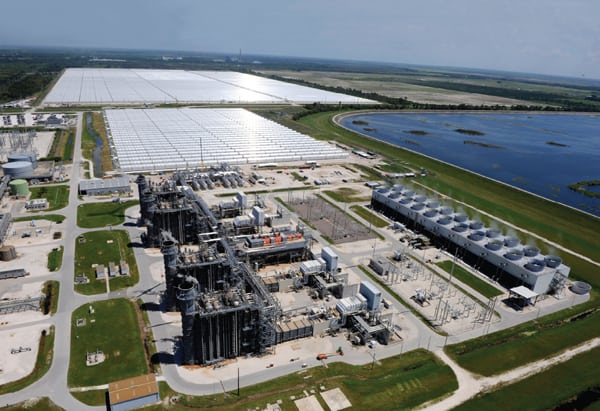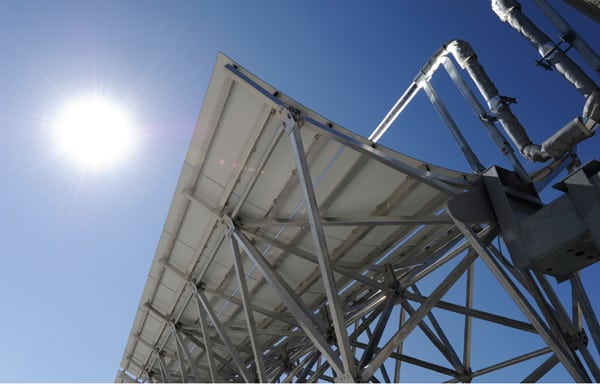Top Plant: Martin Next Generation Solar Energy Center, Indiantown, Martin County, Florida
Owner/operator: NextEra Energy Inc., a subsidiary Florida Power & Light Co.
The 75-MW Martin Next Generation Solar Energy Center is the first hybrid solar facility in the world to combine a solar thermal array with a combined cycle natural gas power plant. Because the facility uses a steam turbine, transmission lines, and other infrastructure from an existing combined cycle unit, financial savings of approximately 20% were achieved compared to what a similar stand-alone solar plant would have cost.
 |
| Courtesy: Florida Power & Light Co. |
Located in a region that has abundant wetlands, wildlife, and bald cypress trees, the new 75-MW Martin Next Generation Solar Energy Center is protecting the environment by harnessing the power of the sun to generate zero-emission electricity. By using solar energy to supplement the power production of an adjacent gas plant, the plant’s innovative technology helps reduce Florida’s carbon footprint. The plant will decrease fossil fuel usage by more than approximately 41 billion cubic feet of natural gas over the project’s lifetime. The mirrors used in the parabolic trough arrays require no fuel or additional cooling water and produce no waste.
The Florida Power & Light (FPL) facility was completed on schedule and more than $75 million under budget. It entered commercial operation in December 2010 and is projected to produce 155,000 MWh per year, which is enough to serve almost 11,000 homes or 26,000 people.
“The solar trough technology FPL is using at the new Martin facility is an advanced version of the proven technology being used by NextEra Energy’s other major subsidiary, NextEra Energy Resources, at the Solar Energy Generating Systems (SEGS) in California’s Mojave Desert,” Timothy Bryant, Martin Next Generation Solar Energy Center production manager, told POWER in October. “SEGS is the largest solar thermal site in the world, and the new Martin facility is the largest in the eastern United States.”
Facility Overview
Bryant explained how the solar and combined cycle technologies are tied together so that “when the sun is shining, plant operators can effectively take their foot off the gas and allow the sun to help generate power.”
Spanning more than 500 acres on the company’s 11,300-acre Martin Plant site, the new solar facility consists of more than 190,000 mirrors carefully placed in trough alignments to capture the sun, similar to the way a magnifying glass operates (Figure 1).
 |
| 1. Catching rays. The new Martin Next Generation Solar Energy Center consists of more than 190,000 mirrors arranged in solar troughs. Centered in the 284 rows of assemblies totaling almost 53 miles are heat-collection elements—20,000 vacuum-sealed, stainless steel tubes, each more than 13 feet long. Inside the tubes are nearly 800,000 gallons of a highly specialized heat-transfer fluid that runs between the solar field and the steam plant within more than 18 miles of carbon steel piping. Courtesy: Florida Power & Light Co. |
The mirrors are arranged in 6,816 solar collection assemblies (SCAs) consisting of 28 mirrors per assembly, he said. Advanced tracking technology maximizes the efficiency of the troughs as the sun moves across the sky over the course of a day.
Centered in the 284 rows of assemblies totaling almost 53 linear miles are heat-collection elements—20,000 vacuum-sealed, stainless steel tubes, each more than 13 feet long. Inside the tubes are nearly 800,000 gallons of a highly specialized heat transfer fluid that moves from the field to the steam plant and back again within more than 18 miles of carbon steel piping.
The fluid is heated by the sun to approximately 740F and then pumped over to a heat exchanger at a steam plant. There, energy from the heat transfer fluid is extracted to create steam that is then integrated into a steam cycle at one of the natural gas–fired, combined cycle generation units at the site.
Of the approximately 300 contracts awarded on the project, more than half went to Florida companies, Bryant said. Materials managers purchased recycled aluminum from a company in St. Augustine, steel pylons from an Orlando firm, road material from a quarry in Port Mayaca, and lumber from Indiantown. The primary construction contractor was Lauren Engineers and Constructors, Inc., of Abilene, Texas.
When the section of the site where the solar arrays are located was originally licensed in 1989, it was intended to be used for a coal-powered generation unit. The wetlands easement license made sure that all impacted areas were properly mitigated and created a 1,130-acre conservation easement and preserved 291 acres of surrounding area. FPL has protected the easement and preservation areas for more than two decades. Now the area is being used for clean, renewable solar energy instead of coal-fired generation.
Technical Challenges
“Differences between conditions in the California desert, where the large SEGS facility is located, and those in Florida led FPL to adopt a number of structural innovations during construction of the Martin facility,” Bryant said.
The arrays, which stand nearly 30 feet tall, were developed to withstand 130-mph winds by anchoring them with foundations larger than those used at the SEGS facility. The more than 6,800 frames that support the mirrors and heat-collection elements are complex trussed structures. Due to the potential for high winds, the SCA frames were designed and constructed to be much more rigid than desert-based frames, minimizing wind-related distortion and the likelihood of breakage.
Costs
The most recent estimated cost of the solar generation component for the Martin Next Generation Solar Energy facility is approximately 27 cents per kWh, which is higher than the 11 cents per kWh cost of generation from a new combined cycle gas fired unit, according to Bruce Kullman, Martin Next Generation Solar Energy Center senior operations specialist.
The Martin solar plant qualified for a federal investment tax credit of about $120 million, which will be passed on directly to customers to help lower the construction costs of the project.
Regional Economic Growth
At a time when Florida is suffering from the aftermath of the worst economic downturn in decades and has an unemployment rate in the double digits, the Martin Next Generation Solar Energy Center is having a significant positive economic impact on customers and local economies.
Approximately 1,100 jobs were created during the construction phase of the project, and FPL matched the skills of local workers with project needs as much as possible. As a result, more than half of the construction jobs were filled by workers from Martin County and nearby Okeechobee and St. Lucie counties. Six permanent employees now work at the Martin solar site. Other employees have been added to the Martin crews to handle solar field operational and maintenance activities, which include 52 preventive maintenance procedures, 16 new operating procedures, six operational reliability checks, and 26 major maintenance work packages. Additional contractors have been hired to perform other tasks, including mirror washing, grass cutting, and weeding.
It is estimated that the investment of approximately $400 million in capital spending on the project will generate tax revenues for Martin County schools and other public services of approximately $78 million over the plant’s lifetime.
Future Goals
Not content with their past successes, employees at the Martin Solar Energy Center are focused on increasing the plant’s energy production, improving operational performance, and demonstrating to the electric power industry that this first-of-its-kind facility in the world can be a more cost-effective way to produce solar power.
“We continue to learn how to optimize the performance of the facility and its technological infrastructure to ensure that we are capturing the most energy possible from Florida’s plentiful sunshine,” Kullman said.
—Angela Neville, JD, is POWER’s senior editor.